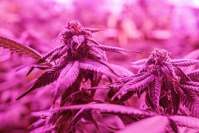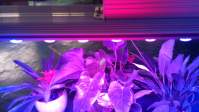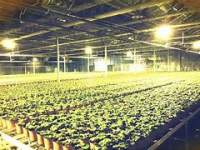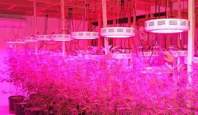LED plant growth lights use light-emitting diodes (LED) as the light source to extract the sunlight spectrum needed to simulate plant growth, and use light to replace sunlight to create plant growth and development, which helps to shorten the growth cycle of plants. The light source is mainly composed of red and blue light sources. Use the most sensitive light band of plants. The wavelengths of red light are 630nm and 640-660nm, and the wavelengths of blue light are 450-460nm and 460-470nm. According to research, the light source of this wavelength can make plants produce the best photosynthesis, so that the plants can obtain the best growth state.
The user groups of LED plant lights are mainly individual users, research institutes, greenhouses, and three-dimensional shapes. Users who like plants use supplementary light to supplement light for plants at home; scientific research institutes are mainly used for experiments, and greenhouses and three-dimensional farms are mainly used for shortening the growth cycle of crops, controlling flowering, and cultivating cash crops. With the legalization of marijuana in parts of Europe and the United States, more and more users have begun to use LED plant lights to grow marijuana. With the help of LED plant growth lights, the production and quality of cannabis have been significantly improved.
LED lights can last for thousands of hours and have better energy efficiency. This makes them an excellent choice for home and commercial use. Every ordinary LED light has its own unique spectrum, and different LED lights also have different spectrums. It's up to your luck that LED lights can cover a part of the plant's growth needs. Because the color temperature, spectrum, and illuminance are uncertain, LED lights are not suitable for plants to supplement light.
The first is brightness. According to different types of plants, for example, shade-tolerant plants and light-loving plants require different intensities; the second is spectrum, where plants absorb different wavelengths of light differently, and different wavelengths of light have different effects on plants. . In short, the blue light around 450nm has an effect on the synthesis, budding, and photosynthesis of proteins and organic acids. Red light near 660 nm has an effect on the formation of carbohydrates, such as the flowering of flowering plants.
The sensitivity of plants to the spectrum is different from that of the human eye. The most sensitive spectrum of the human eye is 555nm, which lies between yellow and green. The sensitivity to blue and red light is poor. On the other hand, plants are most sensitive to red light and less sensitive to green light, but the difference in sensitivity is not as large as that of human eyes. The region where plants are most sensitive to the spectrum is 400-700nm. This spectral region is usually called the effective energy region of photosynthesis. Approximately 45% of sunlight energy is in this part of the spectrum.
If artificial light sources are used to supplement the amount of light, the spectral distribution of the light source should also be close to this range. The photon energy emitted by the light source varies with wavelength. For example, the energy of 400nm (blue light) is 1.75 times that of 700nm (red light). But for photosynthesis, the two wavelengths have the same effect. The excess energy in the blue spectrum that cannot be used for photosynthesis is converted into heat. The photosynthesis rate of plants is determined by the number of photons that plants can absorb at 400-700nm, and has nothing to do with the number of photons emitted by each spectrum.
Light energy is absorbed by the chlorophyll and carotene in the leaves. Two photosynthesis systems convert glucose and oxygen into energy to fix water and carbon dioxide. This process uses all the visible light spectrum, so the effects of light sources of different colors on photosynthesis are almost the same. Some researchers believe that the red part of orange has the greatest photosynthesis capacity. But this does not mean that plants should be cultivated under this monochromatic light source. For the development of plant morphology and leaf color, plants should receive a variety of balanced light sources. The blue light source (400-500nm) is very important for plant differentiation and stoma regulation. If the blue light is insufficient and the ratio of far red light is too much, the stems will grow excessively, which will easily cause the leaves to turn yellow. The ratio of the energy of the red spectrum (655-665nm) to the energy of the far-red spectrum (725-735nm) is between 1.0 and 1.2, which is positive for the development of plants. But each plant has a different sensitivity to these spectral ratios.
Plant growth, from photosynthesis to nutrient production, each stage requires different wavelengths of spectrum irradiation, that is, full-spectrum sunlight, and the spectrum of LED plant lights can meet the needs of plant growth, because it is specifically tailored for plants .
LED lights do not have such a rich spectrum, because they are not designed to supplement light for plants. LED lights are more used for people's life lighting. With the advancement and development of LED technology, various LED lights are gradually replacing traditional lamps. Appears in people’s lives. Compared with traditional lamps, LED lamps emit better light sources and consume less energy. The lamps themselves do not have any harmful substances and polluting materials. They are safe and environmentally friendly to use, and generate low heat during work. The time limit is the advantage of multiple multiples of traditional lamps.
Now all products are progressing and innovating, and each product has its own functional advantages, just like LED lights and LED plant lights. The difference between them is that they are used in different scenes and environments. One is only used in plant cultivation and the other is used in people's lives, and the functions are also different. If you are a grower, you can choose LED plant lights, if you are household or commercial lighting You can choose LED lights, which will bring different surprises.






